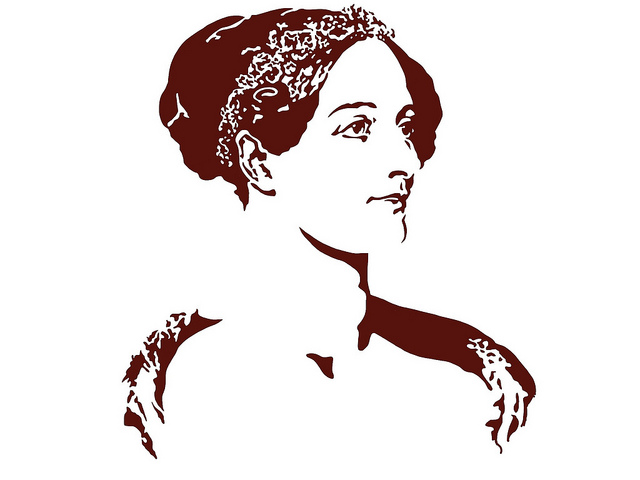 I’m not, in general, huge on holidays. I often wish that those of us in the U.S. would observe the weeks between Halloween and Martin Luther King, Jr., Day with a nice long nationwide nap. But I feel differently about Ada Lovelace Day, founded by British digital-rights activist Suw Charman-Anderson in 2009. Now, every year in mid-October, the world has a chance to recognize Lady Ada, the woman some call the first computer programmer.
I’m not, in general, huge on holidays. I often wish that those of us in the U.S. would observe the weeks between Halloween and Martin Luther King, Jr., Day with a nice long nationwide nap. But I feel differently about Ada Lovelace Day, founded by British digital-rights activist Suw Charman-Anderson in 2009. Now, every year in mid-October, the world has a chance to recognize Lady Ada, the woman some call the first computer programmer.
This year, Ada Lovelace Day arrives with a fine new Lovelace biography, Ada’s Algorithm: How Lord Byron’s Daughter Ada Lovelace Launched the Digital Age. The last major standalone biography of Lovelace was published in the late 1990s, and a lot has happened since then: a new set of letters between Lovelace and her collaborator Charles Babbage was discovered in 2000, and we’ve all clicked and poked and LOLed our way through another decade of the digital age. Ada’s Algorithm argues that Lovelace was one of the first—if not the first—to foresee just how deeply computing would affect our lives.
During Lovelace’s short life—she died of uterine cancer in 1852, at the age of 36—she was well-known in her native Britain, but not for her own accomplishments. She was the only legitimate child of the Romantic poet Lord Byron, who was at least as famous for his epically scandalous behavior as he was for his poetry. (Byron’s reputation overshadows his daughter’s even in death, and some biographies of Lovelace spend most of their oxygen on her father’s exploits, even though Lovelace never knew him. Byron does make it into the subtitle of Ada’s Algorithm, but author James Essinger hustles him offstage relatively quickly.)
Lovelace’s mother, determined that her daughter not follow Byron’s dissolute footsteps, kept the young Ada to a strict schedule of lessons and chores. Lovelace didn’t like the constraints, but she loved learning, and she was especially taken with the possibilities of math and science. Her early letters are filled with dreams of flying machines. “As soon as I have got flying to perfection, I have got a scheme about a steamengine,” a teenaged Lovelace wrote to her mother.
Her life’s work began in earnest when she met Charles Babbage, a mathematician and inventor whose design for an Analytical Engine is frequently described as the world’s first computer. When Lovelace and Babbage met at a London society party in 1833, she was 17 and he was 43, but they soon formed an intellectual partnership that lasted for the rest of Lovelace’s life. Her novella-length description of Babbage’s engine and its potential suggests that she understood the machine even better than its inventor. “The Analytical Engine does not occupy common ground with mere ‘calculating machines,'” she wrote:
A new, a vast, and a powerful language is developed for the future use of analysis, in which to wield its truths so that these may become of more speedy and accurate practical application for the purposes of mankind than the means hitherto in our possession have rendered possible.
Lovelace even predicted that the machine’s binary system would one day be used to program and play pieces of music.
Lovelace’s papers and letters reveal her as not only a gifted mathematician and analytical thinker, but also a talented communicator of science with a lovely knack for metaphor. It’s tempting to credit her Byronic blood for her skill with language, but I like to think of it as all her own—just more evidence of the depth of her insight.
A whole day in honor of Ada Lovelace might seem excessive. Why not a day for Alan Turing or Steve Jobs, both of whom had arguably much more influence on the technology we use today? Lovelace’s accomplishments are worth recognizing for their own sake, but I say we need her as a symbol, too: a symbol of all the women who have contributed to the progress of science and technology, and of all the women who might have contributed if given the chance. For generations, too many brilliant people—women and others—have been systematically excluded not only from the development of technology but also from decisions about its use. We’ve all lost something as a result.
Because Lovelace happened to be educated, wealthy, and famous, her intelligence was recognized by many, even in her own time. (Babbage was also unusually generous about sharing credit.) Countless other similarly gifted women have been ignored or forgotten. Countless more still suffer from sexist attitudes within their industries and, worse, terrifying harassment online and off. Many of the events around Ada Lovelace Day are designed to correct the historical record and build support for present and future Adas.
So today, take a moment to honor Lady Ada—and all the far-seeing and furiously brilliant women in your own life, whatever their passions may be. Happy Lady Ada Day.
Top image: Ada Lovelace by Flickr user Dino Gravato. Creative Commons.
P.S. Remember Girl Bilbo? That tricksy little burglar celebrated Ada Lovelace Day by opening a Twitter account. Follow her for commentary on gender, kidlit, and dragonslaying.
2 thoughts on “Happy Lady Ada Day”
Comments are closed.